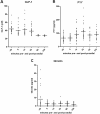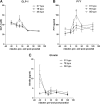Suggestion of new possibilities in approaching individual variability in appetite through constitutional typology: a pilot study
- PMID: 22889232
- PMCID: PMC3502388
- DOI: 10.1186/1472-6882-12-122
Suggestion of new possibilities in approaching individual variability in appetite through constitutional typology: a pilot study
Abstract
Background: Appetite is intricately connected to eating behaviors and shows a high individual variability. In an attempt to approach the problem of gut hormone profiles, appetite, and eating behaviors at the individual level, we have adopted a constitutional typing system widely used in traditional East-Asian medicine, the Sasang constitutional typology, in order to determine the individual variations in appetite, eating behavior, and weight change.
Methods: This pilot study was designed to investigate the variability of appetite among individuals by tracking the gut hormone patterns across different constitutional types. Pre- and post-prandial concentrations of anorectic (peptide YY (PYY), glucagon-like peptide 1 (GLP-1)) and orexigenic (active ghrelin) gut hormones were measured in healthy, normal-weight (18.5 kg/m2 ≤BMI <23 kg/m2) male subjects aged 20-35 (Soyang (SY) (n = 9), Taeeum (TE) (n = 9), and Soeum (SE) (n = 10) constitutional types).
Results: Significant differences were found only in the PYY concentrations across the three groups (p = 0.031). The PYY concentration peaked at 30-min post-prandial in the SE group and was significantly higher compared to the other two groups (p = 0.004). The GLP-1 concentration peaked at 15-min post-prandial in the SE group (not significant). The ghrelin levels at 30-min pre-prandial were relatively lower in the TE group compared to the other groups (not significant).
Conclusions: In conclusion, although with weak statistical power, meaningful gut hormone patterns specific to each constitutional type were discovered in this pilot study, which could offer a new method of approaching the problem of appetite and eating behavior from the angle of individual variability in appetite.
Figures


Similar articles
-
The effect of eating speed at breakfast on appetite hormone responses and daily food consumption.J Investig Med. 2015 Jan;63(1):22-8. doi: 10.1097/JIM.0000000000000119. J Investig Med. 2015. PMID: 25361054 Clinical Trial.
-
Differential changes in appetite hormones post-prandially based on menstrual cycle phase and oral contraceptive use: A preliminary study.Appetite. 2024 Jul 1;198:107362. doi: 10.1016/j.appet.2024.107362. Epub 2024 Apr 16. Appetite. 2024. PMID: 38636667
-
Differences in the levels of the appetite peptides ghrelin, peptide tyrosine tyrosine, and glucagon-like peptide-1 between obesity classes and lean controls.Lab Med. 2024 Sep 4;55(5):553-558. doi: 10.1093/labmed/lmae004. Lab Med. 2024. PMID: 38417041
-
Effects of exercise intensity on plasma concentrations of appetite-regulating hormones: Potential mechanisms.Appetite. 2016 Mar 1;98:80-8. doi: 10.1016/j.appet.2015.12.016. Epub 2015 Dec 22. Appetite. 2016. PMID: 26721721 Review.
-
Appetite-related peptides in childhood and adolescence: role of ghrelin, PYY, and GLP-1.Appl Physiol Nutr Metab. 2015 Nov;40(11):1089-99. doi: 10.1139/apnm-2015-0050. Epub 2015 Aug 6. Appl Physiol Nutr Metab. 2015. PMID: 26466085 Review.
Cited by
-
Re-interpretation of traditional Asian medicine with constitutional perspective.Integr Med Res. 2013 Mar;2(1):1-6. doi: 10.1016/j.imr.2013.01.001. Epub 2013 Jan 25. Integr Med Res. 2013. PMID: 28664047 Free PMC article. Review.
-
Development and validation of the digestive function assessment instrument for traditional korean medicine: sasang digestive function inventory.Evid Based Complement Alternat Med. 2013;2013:263752. doi: 10.1155/2013/263752. Epub 2013 Sep 25. Evid Based Complement Alternat Med. 2013. PMID: 24187572 Free PMC article.
-
Genetic loci associated with changes in lipid levels leading to constitution-based discrepancy in Koreans.BMC Complement Altern Med. 2014 Jul 9;14:230. doi: 10.1186/1472-6882-14-230. BMC Complement Altern Med. 2014. PMID: 25005712 Free PMC article.
-
The obesity-risk variant of FTO is inversely related with the So-Eum constitutional type: genome-wide association and replication analyses.BMC Complement Altern Med. 2015 Apr 15;15:120. doi: 10.1186/s12906-015-0609-4. BMC Complement Altern Med. 2015. PMID: 25888059 Free PMC article.
-
Body temperature regulation: Sasang typology-based perspective.Integr Med Res. 2015 Dec;4(4):189-194. doi: 10.1016/j.imr.2015.08.001. Epub 2015 Aug 17. Integr Med Res. 2015. PMID: 28664126 Free PMC article. Review.
References
Publication types
MeSH terms
Substances
LinkOut - more resources
Full Text Sources

